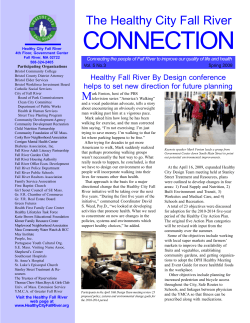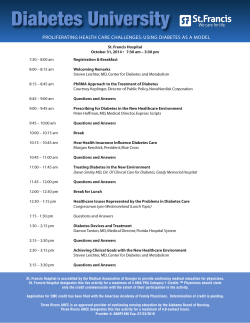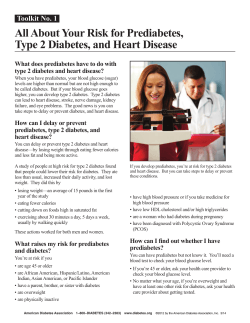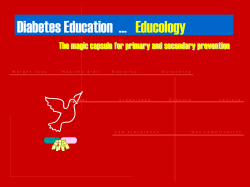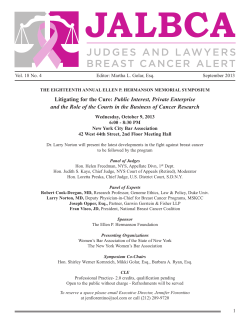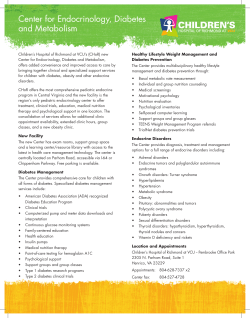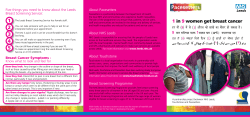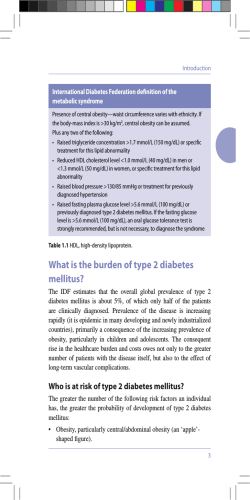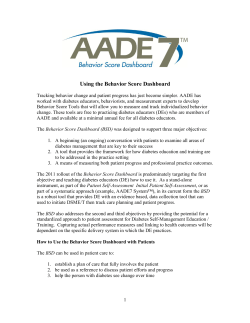
An approach for high risk women : Developing a weight management
An approach for high risk women : Developing a weight management programme for overweight women at high risk for breast cancer, cardiovascular disease & diabetes Dr Michelle Harvie Research Dietitian Genesis Prevention Centre University Hospital of South Manchester Advances in Diabetes and Obesity Care: Therapy, Treatments and Techniques May 14 2012 Outline Weight, weight loss & risk of cancer, diabetes & CVD The NHS Breast Screening Programme Cardiovascular & diabetes screening Our planned Healthy Lifestyle Promotion at Screening (HeLPS) programme Multivariate RR Weight gain & risk of breast cancer 2.0 2 1.6 1.2 1.0 1 0 Loss or Gain gain 2.0 2.1-10.0 (Reference) Gain 10.1-20.0 Gain >20.0 Adult weight change (kg) Huang et al JAMA 287: 1407, 1997 Weight gain & risk of breast cancer, diabetes & CVD 12.3 Diabetes Multivariate RR 10.2 Metabolic Syndrome 2.0 2 2.7 CVD 1.6 1.2 1.0 1 0 Loss or Gain gain 2.0 2.1-10.0 (Reference) Gain 10.1-20.0 Gain >20.0 Adult weight change (kg) Huang et al JAMA 287: 1407, 1997, Colditz GA et al Arch Int Med 122: 481, 1995 Willett W et al JAMA 273: 461, 1995 Everson SA et al Diabetes Care 21: 1637, 1998 Modest weight loss reduces risk of cancer & diabetes Study design Wt loss RR Reference Cohort 34,000 postmenopausal women USA > 5% 0.61 (0.46 – 0.80) Harvie et al 2005 Breast cancer Cohort 87,000 postmenopausal women USA >10kg ~ 15% 0.43 (0.25 – 0.86) Eliassen et al 2006 Colorectal cancer Cohort 7963 Japan 30% female aged > 40 > 5% 0.47 (0.26 – 0.82) Yamaji et al 2008 Diabetes RCT 2766 IGT USA 68% women 45% ethnic minority > 5% 0.64 (0.76 – 0.58) USDPP 2009 Breast cancer Modest weight loss & risk of cardiovascular disease Wing et al Diabetes Care. 2011 34(7):1481-6 RCT data US Diabetes Prevention Study RR 0.38 (0.08 – 1.68) results expected 2014 Da Quing Diabetes Prevention Study RR 0.72 (0.47 – 1.12) Can we provide lifestyle disease prevention in the NHS National Breast Screening Programme ? Rationale for lifestyle disease prevention in the NHS BSP • NHSBSP reaches 70% of women 47 – 73 years • NHSBSP allows early diagnosis & improved BC survival, but does not target prevention. • 30- 40% of BC may be preventable by weight control, exercise & reduced alcohol WCRF/ Cancer Reform Strategy • Excess weight & poor lifestyle linked to most chronic diseases i.e. CVD , diabetes, other cancers & dementia. • Low cost multi disease prevention interventions are required with limited healthcare budgets. PROCAS Predicting Risk Of Cancer At Screening Aim •Develop risk prediction model for use in the NHSBSP •Assess the feasibility of providing risk information & introducing prevention at screening • Target recruitment 60,000 women over 3 years • Mailed to join study with mammogram invitation 40-50% Screening attendees agree to join study Complete risk information questionnaire & provide saliva sample for SNP analysis Risk data collected in PROCAS Family history Hormonal factors: Risk prediction Parity, age of 1st pregnancy, breast feeding, use of HRT, oral contraceptives Lifestyle factors: BMI Adult weight gain Exercise Alcohol Breast density 20 breast cancer SNPs in saliva samples + PROCAS – First 10,000 women Estimated risks • 94% of women in PR0CAS want to know their risk •10% have > 5% 10 year risk of BC (2 x population risk) Self reported lifestyle risk data • 65% overweight • 65% sedentary • 30% >14 units alcohol /week Why should we include screening & prevention of CVD & diabetes ? • Women in NHSBSP aged 47 – 73 years when CVD & diabetes screening is worthwhile & cost effective National Collaborating Centre of Primary Care. NICE 2010 Waugh N, et al Health Tech Assess 2007 • Current CVD screening & weight management is opportunistic and has poor coverage. Soljak M et al BMC Cardiovasc Disord 2011; 11:12 • We find significant numbers of women in the NHSBSP have previously undiagnosed CVD & diabetes risk profiles: Raised total:HDL chol ratio (50%) Raised Blood sugar (10- 15%) Healthy Lifestyle Promotion at Screening (HeLPS) programme Questions • Is multiple disease risk information acceptable and useful to women? • Can disease risk information information motivate lifestyle behaviour change? • Can we promote weight loss and lifestyle change with a telephone + web / app intervention? • To what extent does this intervention change disease risk biomarkers? Acknowledgements HeLPS Christi Deaton Martin Gibson Anthony Howell Gareth Evans Iain Buchan Louise Donnelly PROCAS Alan Hufton Jenny Diffey Jane Wardle Jack Cuzick Bill Newman Iain Buchan LIFESTYLE Paula Stavrinos Mary Pegington Debby McMullen Sarah Dawe Kath Sellers Sarah Sahin Ellen Mitchell Jill Fox Genesis Volunteers. Mary Wilson Wendy Watson Ursula Beetles Pam Coates Fiona Harrison Barbara Eckersley Ruth Warren Sue Astley Sarah Ingham UHSM FUNDING Jamie Sargeant Radiographers National Institute Louise Donnelly & Radiologists of Health Research Victoria Adrinka Genesis Julia Wiseman CLHARC
© Copyright 2025








